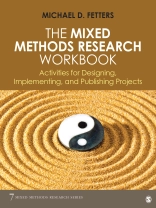Written by Michael D. Fetters, one of the leading scholars in the field and co-editor of the Journal of Mixed Methods Research, The Mixed Methods Research Workbook: Activities for Designing, Implementing, and Publishing Projects is the perfect tool for doctoral students and researchers who want support throughout their research project, as well as a practical way to apply the knowledge they’ve learned. With The Mixed Methods Research Workbook, you’ll be ready to tackle your mixed methods research project with confidence.
Each chapter follows a familiar framework, starting with learning objectives for each piece of the mixed methods process. Readers have ample space in this text to write notes, fill out activities, and begin their process of actively designing and writing up a mixed methods study. This easy-to follow process gives readers an immediate structure to their projects. Exemplar boxes provide a starting framework, with the text encouraging deeper reflection on mixed methods challenges and opportunities. Stories from the field illuminate struggles and suggestions with the benefit of hindsight. Checklists at the end of each chapter help readers stay organized and key resources provide up-to-date lists of material for further study.
From start to finish, readers can follow along with this text as they work on their projects. The text begins by assisting readers in identifying topics and conducting literature reviews in the context of mixed methods, zeroing in to address mixed-methods-specific challenges like integration, leveraging advantages of both qualitative and quantitative methods, and incorporating theory and personal backgrounds. Identifying data sources helps readers organize their data collection. Two chapters on research designs structure the data collection process with procedural diagrams. A unique chapter on mixed methods sampling offers application through basic and advanced designs. The book illustrates integrating and implementing mixed methods designs with practical advice for each of stage of the process. Ethics in a mixed methods context readies readers for the research protocol stage. Several chapters fully explicate the data analysis process, including developing a joint display, a state-of-the-art procedure for analysis and presentation of findings. Closing out the process, the text tackles quality and evaluation in mixed methods studies, preparing your study for publication, and writing up your article.
Table des matières
Series Editors’ Introduction
Preface
Chapter 1 • Identifying a Topic, Rationale, and Potential Feasibility Issues for Conducting a Mixed Methods Research or Evaluation Project
Learning Objectives
Mixed Methods Research in Context
Getting to Work
Brief Review of Key Elements of Qualitative Research
Brief Review of Key Elements of Quantitative Research
Brief Review of Key Elements of Mixed Methods Research
Feasibility Issues and Mixed Methods Research
Application Activities
Concluding Thoughts
Key Resources
Chapter 2 • Getting Started: Identifying a Research Topic for a Mixed Methods Project
Learning Objectives
Identifying Your Research Topic
Translating Your “Idea” to “Ink”
Good Research Ideas Come From Stories
Application Activities
Concluding Thoughts
Key Resources
Chapter 3 • Reviewing the Literature for a Mixed Methods Project
Learning Objectives
Purpose of Your Mixed Methods Research Literature Review
Understanding Different Types of Literature Reviews
Conducting a Focused Literature Review of Your Topic
Rightsizing the Literature Review
Identifying Qualitative, Quantitative, and Mixed Methods Studies
Application Activities
Concluding Thoughts
Key Resources
Chapter 4 • Incorporating Personal Background, Theory, and Worldviews Into Mixed Methods Research
Learning Objectives
Introduction to the “Personal Contexts” Concept
Personal and Professional Experience
Theoretical and Conceptual Models
Philosophical Assumptions
Application Activities
Concluding Thoughts
Key Resources
Chapter 5 • Developing the Background, Research Objectives, and Research Questions for a Mixed Methods Research Project
Learning Objectives
Developing the Background of Mixed Methods Research and Evaluation Projects
Situating the Project in the Broader Literature of the Field
Developing a Working Title
Summarizing the Overarching Context
Identifying a Problem in the Literature
Creating General Research Goals/Objectives
Crafting Mixed Methods Research Questions
Refining the Title of the Mixed Methods Project
Application Activities
Concluding Thoughts
Key Resources
Chapter 6 • Identifying Data Sources for a Mixed Methods Project
Learning Objectives
What Is a Data Sources Table?
Data Collection Procedures
Elements of a Data Sources Table
Application Activities
Concluding Thoughts
Key Resources
Chapter 7 • Creating Procedural Diagrams of Core Mixed Methods Research Designs
Learning Objectives
Getting Started by Choosing a Mixed Methods Design
Spectrum of Fixed and Emergent Mixed Methods Research Designs
Three Core Mixed Methods Designs
Guidelines for Drawing Procedural Diagrams for Mixed Methods Studies
Explanatory Sequential Mixed Methods Research Design
Exploratory Sequential Mixed Methods Research Design
Application Activities
Concluding Thoughts
Key Resources
Chapter 8 • Constructing Procedural Diagrams of Scaffolded Mixed Methods Designs That Expand Upon Core Designs
Learning Objectives
Mixed Methods Designs Beyond Core Designs
Scaffolded Mixed Methods Designs Defined
Steps for Creating a Scaffolded Procedural Diagram From the Beginning
Overview of Seven Workbox Illustrations
1. Fundamentals of a General Multistage Framework
2. Fundamentals of Mixed Methods Designs Integrated With Another Methodology
3. Fundamentals of Methods Designs Integrated With Other Designs
4. Fundamentals of Mixed Methods Designs Integrated With a Theoretical/Ideological Framework
Application Activities
Concluding Thoughts
Key Resources
Chapter 9 • Integrating Through Sampling in Mixed Methods Research
Learning Objectives
Why Sampling Matters
How to Make Decisions About Sampling
Target Population
Sampling Timing
Sampling Relationships
Incorporating Timing and Sampling Relationships Into Specific Mixed Methods Research Designs
Quantitative and Qualitative Sampling Strategies to Incorporate Into Your Mixed Methods Design
Sampling in Quantitative Research
Sampling Strategies for Quantitative Data Collection in Mixed Methods Research
Sampling in Qualitative Research
Sampling Strategies for Qualitative Data Collection in Mixed Methods Research
Sampling Opportunities Arising From Organizational Roles and Functions
Sampling Opportunities Based on Geographic Location
Application Activities
Concluding Thoughts
Key Resources
Chapter 10 • Identifying the Intent of Integration and Illustrating Integration Features in Mixed Methods Procedural Diagrams
Learning Objectives
Integration During Data Collection and Analysis
Integrating Data Collection Strategies Into Mixed Methods Studies
Integration Procedures in Two-Phase Data Collection and Analysis Used in Sequential Designs
Integration Procedures for Mixed Data Analysis
Integration Procedures for Adjunctive Data Collection in Mixed Methods Studies
Adding the Intent of Integration Into Mixed Methods Procedural Diagrams
Data Collection and Analysis Integration Strategies for Explanatory Sequential Mixed Methods Research Designs
Data Collection and Analysis Integration Strategies for Exploratory Sequential Mixed Methods Research Designs
Data Collection and Analysis Integration Strategies for Convergent Mixed Methods Research Designs
Application Activities
Concluding Thoughts
Key Resources
Chapter 11 • Creating an Implementation Matrix for a Mixed Methods Study
Learning Objectives
What Is an Implementation Matrix?
How Can an Implementation Matrix Be Used?
Developing an Implementation Matrix
Creating a Mixed Methods Implementation Matrix
Steps for Creating an Implementation Matrix
Additional Elements That Can Be Added to an Implementation Matrix
Application Activities
Concluding Thoughts
Key Resources
Chapter 12 • Ensuring Ethical Conduct of Research With Human Subjects and Developing a Mixed Methods Research Protocol
Learning Objectives
Why Is Compliance with Human Subjects Research Regulations Important?
Does the Study Qualify as Exempt From Regulatory Oversight?
Why Does Human Subjects Protection in Mixed Methods Research Matter?
What Are Potential Risks to Human Subjects Raised by Participation in a Mixed Methods Research Study?
Discussion of the Language of Human Subjects Versus Human Participants
What Are Potential Benefits of Participation in a Mixed Methods Research Study?
What Is a Mixed Methods Research Protocol?
Why Have a Mixed Methods Research Protocol?
How to Fill in the Research Protocol?
Application Activities
Concluding Thoughts
Key Resources
Chapter 13 • Performing Fundamental Steps of Mixed Methods Data Analysis
Learning Objectives
Why Find Commonality Between Your Qualitative and Quantitative Data?
Seven Fundamental Steps in Mixed Methods Data Analysis
Step 1. Enter, Clean, and Address Gaps or Deficiencies in the Data Based on a Data Collection Inventory
Step 2. Frame the Analysis in Accordance With the Study Purpose
Step 3. Describe Patterns in the Data
Step 4. Use an Organizational Structure for Summarizing the Findings
Step 5. Check for Inconsistencies, Anomalies, or Conflicting Findings
Step 6. Organize the Findings for Dissemination
Step 7. Interpret and Articulate the Findings in Writing Up the Results
Application Activities
Concluding Thoughts
Key Resources
Chapter 14 • Developing a Joint Display
Learning Objectives
What Is a Joint Display?
Joint Display Planning
Joint Display Analysis
Discovering Linkages Between the Qualitative and Quantitative Data for Joint Display Analysis
Steps for Creating a Joint Display Using Joint Display Analysis
Joint Display Innovations: A Circular Joint Display
Application Activities
Concluding Thoughts
Key Resources
Chapter 15 • Applying Advanced Procedures in Mixed Data Analysis
Learning Objectives
What Are Advanced Mixed Methods Data Analysis Procedures?
Why Use Advanced Mixed Methods Data Analysis Procedures?
Determining the Need for Advanced Analysis Procedures
What Are the Different Types of Advanced Mixed Analysis Procedures?
1. Joint Display Analysis
2. Quantitizing—Data Transformation of Qualitative Data Into a Quantitative Form for an Integrated Analysis
3. Qualitizing—Data Transformation of Quantitative Data Into a Qualitative Format for an Integrated Analysis
4. Qualitative Comparative Analysis
5. Geographic Information System Mapping
6. Social Network Analysis
7. Repertory Grid Analysis
8. Imitation Game
Other Choices
Application Activities
Concluding Thoughts
Key Resources
Chapter 16 • Ensuring Mixed Methods Research Integrity: Quality Considerations for Mixed Methods Research and Evaluation Studies
Learning Objectives
Quality and Mixed Methods Research
Three Conceptualizations of Mixed Methods Quality
Mixed Methods Research Integrity
Consideration of the Research Quality Issues Relative to the Qualitative and Quantitative Research
Assessing for Threats to Quality in Qualitative Research: Trustworthiness
Assessing for Threats to Quality in Quantitative Research: Validity, Reliability, Generalizability, Reproducibility, and Replicability
Assessing for Threats to Quality in Mixed Methods Research and Evaluation Projects
Research Integrity: Quality Assessment in the Methods
Consideration of Research Integrity Issues From the Methodological Perspective: The Legitimation Framework
The Legitimation Perspective on Quality in the Methodology of Mixed Methods Research and Evaluation Projects
A Program Approach to Mixed Methods Quality: O’Cathain’s Research and Evaluation Quality
Application Activities
Concluding Thoughts
Key Resources
Chapter 17 • Preparing for Submission of Mixed Methods Research and Evaluation Articles for Publication
Learning Objectives
Publishing Opportunities When Conducting Mixed Methods Research and Evaluation Projects
Should I Write Empirical or Methodological Papers?
Conducting a Project Inventory for Publishing Mixed Methods Research and Evaluation Studies
Selecting Target Journals for Submitting Mixed Methods Research and Evaluation Studies
Identifying Candidate Journals and Rating Them as Submission Destinations
Developing a Comprehensive Publication Plan
Application Activities
Concluding Thoughts
Key Resources
Chapter 18 • Writing a Mixed Methods Article Using the Hourglass Design Model
Learning Objectives
What Are the Publication Formats for Mixed Methods Articles?
Recognizing Your Writing Strengths and Identifying Strategies to Write: Write Early and Write Often
Unique Features and Strategies for Writing a Mixed Methods Title
What Is the Hourglass Model of Writing?
Unique Features and Strategies for Writing a Mixed Methods Article or Chapter
Creating an Outline for Your Dissertation or Thesis
Application Activities
Concluding Thoughts
Key Resources
Appendix 1. Mixed Methods Research in Business Example
Appendix 2. Mixed Methods Research in Education Example
Appendix 3. Mixed Methods Research in the Health Sciences Example
Glossary
References
Index
A propos de l’auteur
Michael D. Fetters, M.D., M.P.H., M.A., is a professor of family medicine at the University of Michigan (U-M) where he directs the Japanese Family Health Program. In addition, Dr. Fetters pursues the same educational goals as an adjunct professor and consultant to Shiga Medical University in Shiga Prefecture, Japan. An international expert in mixed methods research, Professor Fetters has taught multiple mixed methods workshops domestically and internationally in Canada, Denmark, and Japan. He helped coordinate the first Mixed Methods Conference in Japan in 2013 by serving on the organizing committee and presenting. With Family Medicine Adjunct Professor John W. Creswell, he founded and co-directs the University of Michigan Mixed Methods Research and Scholarship Program. He serves as Editor for the Journal of Mixed Methods Research.












